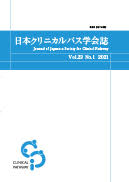Volume 8, Issue 3
Journal of Japanese Society for Clinical Pathway Vol.8 No.3 2006
Displaying 1-14 of 14 articles from this issue
- |<
- <
- 1
- >
- >|
Original Article
-
Article type: Original Article
2006 Volume 8 Issue 3 Pages 199-204
Published: September 28, 2006
Released on J-STAGE: March 28, 2024
Download PDF (2195K) -
Article type: Original Article
2006 Volume 8 Issue 3 Pages 205-213
Published: September 28, 2006
Released on J-STAGE: March 28, 2024
Download PDF (3628K)
Annual Congress Reports (The 6th Annual Congress)
-
Article type: other
2006 Volume 8 Issue 3 Pages 217-219
Published: September 28, 2006
Released on J-STAGE: March 28, 2024
Download PDF (1089K) -
Article type: other
2006 Volume 8 Issue 3 Pages 221-223
Published: September 28, 2006
Released on J-STAGE: March 28, 2024
Download PDF (1376K) -
Article type: other
2006 Volume 8 Issue 3 Pages 225-226
Published: September 28, 2006
Released on J-STAGE: March 28, 2024
Download PDF (892K)
Annual Congress Reports (The 6th Annual Congress)
-
Article type: other
2006 Volume 8 Issue 3 Pages 227-229
Published: September 28, 2006
Released on J-STAGE: March 28, 2024
Download PDF (1099K)
Annual Congress Reports (The 6th Annual Congress)
-
Article type: other
2006 Volume 8 Issue 3 Pages 231-233
Published: September 28, 2006
Released on J-STAGE: March 28, 2024
Download PDF (1145K)
Annual Congress Reports (The 6th Annual Congress)
-
Article type: other
2006 Volume 8 Issue 3 Pages 235-240
Published: September 28, 2006
Released on J-STAGE: March 28, 2024
Download PDF (2392K) -
Article type: other
2006 Volume 8 Issue 3 Pages 241-243
Published: September 28, 2006
Released on J-STAGE: March 28, 2024
Download PDF (1090K)
Report on the Clinical Pathways Seminar Study Tour
-
Article type: other
2006 Volume 8 Issue 3 Pages 247
Published: September 28, 2006
Released on J-STAGE: March 28, 2024
Download PDF (484K) -
Article type: other
2006 Volume 8 Issue 3 Pages 248-250
Published: September 28, 2006
Released on J-STAGE: March 28, 2024
Download PDF (1080K) -
Article type: other
2006 Volume 8 Issue 3 Pages 251-252
Published: September 28, 2006
Released on J-STAGE: March 28, 2024
Download PDF (722K) -
Article type: other
2006 Volume 8 Issue 3 Pages 253-255
Published: September 28, 2006
Released on J-STAGE: March 28, 2024
Download PDF (1038K) -
Article type: other
2006 Volume 8 Issue 3 Pages 256-257
Published: September 28, 2006
Released on J-STAGE: March 28, 2024
Download PDF (799K)
- |<
- <
- 1
- >
- >|
